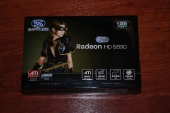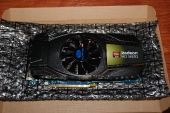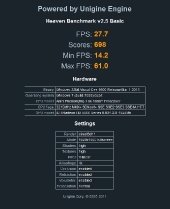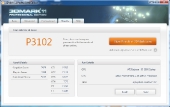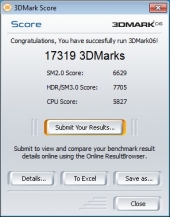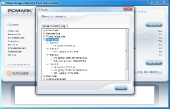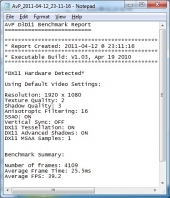
Introduction
Sapphire’s Xtreme Series offers great value with great performance. Here’s a quote from Sapphire:
Hailed as the most exciting development in graphics for several generations, the original SAPPHIRE HD 5800 series not only included the fastest single GPU available, but was also the first family of video cards in the world to support the advanced graphical features of Microsoft DirectX 11 and multi-monitor displays in Eyefinity mode. Now it’s back – with the exciting new SAPPHIRE HD 5800 series Xtreme Editions!

The 5830 Xtreme:
Today we are checking out Sapphire’s release of the 5830 Xtreme which promises more performance for less cash and the ability to squeeze out even more. The box is bold and one of the few worth actually looking at as its filled with useful information and statistics on the 5830 hidden inside. The 5830 fills in the low end of the 58XX series GPU’s but don’t be fooled by its low number the 5830 packs more than enough punch for many gamers and enthusiasts as we will shortly explain.
Where the Rubber Meets the Road:
Many consumers still don’t have the financial freedom to lay out $300+ of their hard earned cash on a high end video card, nor do they really need the power that a 69xx series card brings to the table. Some consumers simply don’t have the need for high end 3D and are content with video playback and minor 3D capabilities. In either case this is still a 58XX series card with some excellent features, a high end brand name, and a low price. Sounds like a good combination, so will it handle your needs? Lets find out.
A Video Card for You:
The Sapphire 5830 Xtreme is targeted towards consumers where horsepower may not be at the top of the list but price is. With a $129 retail pricetag the Sapphire 5830 Xtreme is sure to put a smile on many buyers faces. By the same token these same consumers want a card that delivers more than the numbers on the side of the box, Sapphire knows this and the Xtreme series delivers with the included Sapphire TriXX Utility.
![]()
This software program assists you in overclocking the card to its maximum potential in a safe environment. With control over the Core and Memory speeds some are reporting as much as 20% headroom which is a lot of extra performance given the budget nature of the card.
Lets look at some quick specs on this card.
Specifications:
| Overview | |
| Output | 1 x Dual-Link DVI 1 x HDMI 1 x Mini-DisplayPort |
| GPU | 800 MHz Core Clock 40 nm Chip 1120 x Stream Processors |
| Memory | 1024 MB Size 256 -bit GDDR5 4000 MHz Effective |
| Software | Driver CD Sapphire TriXX Utility |
| Accessory | DVI to VGA Adapter 6 PIN to 4 PIN Power Cable x 2 |
For a card with a budget price tag it certainly seems to have gamers in mind. A lower 40nm chip design means lower temps and usually better overclocking, With Dual-Link DVI, HDMI, and Mini-Display Port outputs the Sapphire 5830 has you covered for connectivity. The card comes with a full 1GB of GDDR5 ensuring you enough memory for the more demanding applications.
What we don’t see in these specifications are features like:
- ATI Eyefinity Multi-Display
- CrossFireX Ready
- Microsoft DirectX 11
- PCI Express 2.1
- Shader Model 4.1
So how does this card differ from the regular 5830 and the 5850/5850 Xtreme?
Click On the Thumbnail for a Larger Image
This is a really large chart so let it load, but it does help to make clear the differences between each of the cards. Basically the 5830 actually has a higher core clock speed than the 5850 Xtreme, 800 MHz vs 725Mhz and the same memory frequency at 4000MHz. The primary difference between these cards is in the Shader Pipelines which in the case of the 5850 has 1440 while the 5830 has 1120. Oddly enough the 5830 Xtreme has a higher maximum power draw of 175W vs the 5850’s 170W and both the Xtreme models of the 5850 and 5830 support a maximum resolution of 1920 x 1200 vs the non-Xtreme versions higher limit of 2560 x 1600.
Sapphire has chosen to compare the 5850 to the Nvidia 285 while the 5830 is compared to the Nvidia 275. This is probably a fair assessment of its relative strength in gaming and 3D performance aside from feature sets.
–~~~~~~~~~~~~–
Test Machine:
Chassis: NZXT Phantom
Motherboard: ASUS Crosshair IV Formula Motherboard
Processor: AMD Phenom II 1090T
Memory: OCZ ELV Platinum DDR3 1600 4GB RAM Kit
Storage: Western Digital 1TB Black
Operating System: Windows 7 Professional 64bit
Video Drivers: AMD Catalyst Software Suite 11.3
Our Testing Suite Included:
- Unigine Heaven DX11 Benchmark 2.5
- FutureMark 3DMark 11 Pro
- FutureMark 3DMark Vantage Pro
- FutureMark 3DMark 06 Pro
- PCMark Vantage
- Aliens vs Predator DX11 Benchmark
Unigine Heaven DX11 Benchmark 2.5

Click On the Thumbnail for a Larger Image
Unigine Heaven presents a large DX11 rendered environment with many objects and a lot of lighting effects. The 5830 Xtreme did very well mustering almost FMV at 27.7 FPS average. The framerate dipped as low as 14.2 and went as high as 61. During most of the benchmark the playback was pretty smooth.
FutureMark 3DMark 11 Pro
Click On the Thumbnail for a Larger Image
As we have previously mentioned the new 3DMark 11 is a torture test for any current graphics card. This test comes with presets for Entry, Performance, and Extreme. As you can see by the graphic above, we ran this test in Performance mode. The Extreme test is best suited for SLI or Crossfire configurations as anything else results in watching a slide show for most of the benchmark. As you can see the 5830 Xtreme scores well but not exceptional on this test. Considering the nature of the card and its price point I would call this a win for Sapphire.
FutureMark 3DMark Vantage Pro
3DMark vantage – 1280 x 1024
3DMark vantage 1920 x 1200
This benchmark more accurately portrays the performance that you can expect to see in the majority of applications using DX10 and video playback. 3D performance becomes much more acceptable approaching FMV (30fps) and easily surpassing 30fps at a resolution of 1280 x 1024. This places the card as an excellent choice for anyone seeking to have an enjoyable gaming experience on DX10 titles using a 1280 resolution.
At 1920 x 1200 we see the 5830 struggling to produce 30fps though its average framerate is just a bit shy of that mark. This still shows that full HD playback of almost any content you could throw at this card it can handle.
–~~~~~~~~~~~~–
FutureMark 3DMark 06 Pro
Click On the Thumbnail for a Larger Image
The aging nature of 3DMark 06 is starting to show here as the 5830 Xtreme blows through this test with ease getting a relatively good score of 17,319 in what used to be a very demanding test.
PCMark Vantage
Click On the Thumbnail for a Larger Image
We ran only the graphics portion of this test to provide you with relevant video performance. As you can see the 5830 Xtreme scored very well in each of the gaming tests earning a score of 7724 in the gaming portion of PCMark Vantage.
Aliens vs Predator D3D11 Benchmark
Click On the Thumbnail for a Larger Image
This benchmark once again tests the DX11 capability of the 5830 Xtreme under high resolution settings. At 1920 x 1080 the 5830 proves it can delivery a great gaming experience with an average framerate of 39.2fps. At the settings above you are delivered DX11 at a good resolution. This simply proves that not enabling every high end feature within a game can significantly increase your gaming experience.
Observations
During our testing we continually checked the heat output from the card. Our measurements were taken using a laser thermal probe placed within 1/2 inch over the back of the card and centered over the GPU chip. The 5830 at idle measured 39.4 Celsius while during gaming rose to a maximum of 66.1 Celsius. While more than a bit warm for our liking this is significantly cooler than our reference high end card a 5970 which produces a staggering amount of heat during the same testing and will reach temperatures of 71 to 75 Celsius.
Heat output is very important to consider as is the manufacturers cooling solution. The importance of this can be very easily seen when looking at the history of cards from Nvidia. As recently as a year ago Nvidia was hit with a class action lawsuit regarding the untimely death of an entire range of cards powered with their chips due to heat output among other factors. The reference design of a video card includes its heatsink and is one of the important ways in which a manufacturer like Sapphire can differentiate themselves in the market. In this regard Sapphire has done an excellent job producing a heatsink which is efficient, functional, and also lightweight. The heatsink included with the 5830 Xtreme has a center placed fan with triple heatpipes and a copper base for direct contact and heat distribution from the GPU.
We’d like to give Sapphire a major thumbs up for delivering an innovative design, good performance, and at an excellent price. If you are looking for a speed bump in performance which brings you to DX11 capability in your games without breaking the bank, the Sapphire 5830 Xtreme is an awesome solution to consider.

